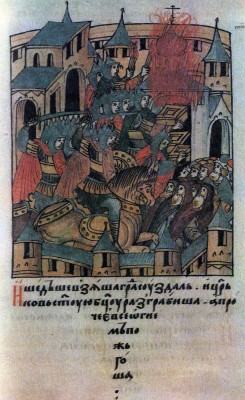Chronicle-Writing
The feudal disunity of Russia, which was particularly strong during Mongol overlordship, promoted the development of local and regional chronicle-writing. This had two consequences. On the one hand, the chroniclers’ field of vision became narrower to some extent. On the other hand, the emergence of regional chronicle- writing led to the inclusion of local material in chronicles. At the same time the tradition of beginning a chronicle with The Tale of Bygone Years became established and lasted for many centuries (from the eleventh to the sixteenth). This helped to strengthen people’s awareness of the unity of Russia. Irrespective of where they were written, the chronicles recount the history of the whole Russian land. In this way they reminded people of the unity of the Russian principalities and aroused memories of the glorious past and former might of Russia.

Batu Captures Suzdal. Illumination from The Illustrated Chronicle. 16th century, demy of Sciences Library, Leningrad
The development of local chronicle-writing did not mean that the chronicle’s interests became limited to the region or land in question. Local chronicle-writers constantly made use of material from chronicles of other principalities in their work. It is by no means always possible to trace and explain the ways in which the chronicle-writing of different principalities, even those hostile to one another, interacted, but the existence of this interaction is indisputable.
The nomadic invasion greatly hampered the development of chronicle-writing. But even in the bitterest years of Mongol overlordship it continued to exist. From the devastated towns it moved to other cities, although it was not carried on so intensively in the principalities that had escaped destruction.
 History of Russian Literature
History of Russian Literature
